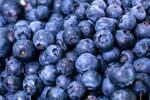
05 Apr Blueberry Extract Studied to Speed Wound Healing
MedicalResearch.com Interview with:

Dr. Klimis-Zacas
Dorothy Klimis-Zacas, MS, PhD, FACN
Professor of Clinical Nutrition
School of Food and Agriculture
Graduate Faculty
School of Biomedical Sciences
Associate Faculty, Institute of Medicine
Fulbright Fellow
University of Maine Orono, Maine 04469
MedicalResearch.com: What is the background for this study?
Response: Bioactive compounds such as polyphenols have been documented to have wound healing properties . In the Klimis-Zacas laboratory, phenolic extracts (PE) from wild blueberries (WB) were reported to promote angiogenesis in HUVEC cells via cell migration, angiogenesis, through VEGF/P13K/AKT pathway documented that the PE, primarily composed of chlorogenic acid significantly promoted cell migration and closure speed of wound by 38% above the control as well as angiogenesis and gene expression for proteins critical for cell movement while the anthocyanin fraction inhibited the above processes (5,6).
MedicalResearch.com: What are the main findings?
Response: In pre-clinical studies with Sprague Dawley rats that dorsal wounds were created, application for seven days of different concentrations of PE fractions and a mixture of phenolic acid fractions and anthocyanins extracted from wild blueberries resulted in promotion of wound healing by speeding wound closure by 22% compared to control. Phenolic acid fractions at specific concentrations promoted angiogenesis compared to control and there were positive trends for downregulation for gene expression of proinflammatory markers and upregulation or pro-angiogenic proteins.
Study Presented at Experimental Biology Meeting
Armed with the above knowledge, and in partnership with an industry partner we developed two prototypes, one gel/serum and one cream that contain PE at specific concentrations to study their potential for skin regeneration, vascularization and inflammation related to wound healing. These prototypes were tested in pre-clinical studies with Sprague Dawley rats on dorsal wounds at different concentrations after application for seven days. Speed of wound closure was 12% higher and vascularization was 20% higher in the gel-product with PE at a specific concentration compared to control. Compared to wound healing products in the market that speed wound closure only by approximately 6%, our product is superior. We are presently analyzing the wounds (skin tissues) for angiogenesis, re-epithelialization, organized collagen formation, and inflammation markers as well as conducting histological studies to image angiogenesis and fibrosis.
MedicalResearch.com: What should readers take away from your report?
Response: Discovering new therapeutic modalities for wound healing, especially plant extracts will aid millions of people by decreasing chronic wound complications and amputation with subsequent effects on decreasing health care costs in the US and globally. This product will improve the quality of life and decrease hospital stays thus decreasing medical costs in people suffering from diabetic wounds, pressure ulcers, burns, severe trauma, venous leg ulcers, post-surgical wounds, scarring and other chronic health conditions. Third world country persons suffering from the above conditions can be especially benefited from this biomedical product due to its low cost, no side effects, easy application and all “natural nature”. Additionally, it has application to our national security because it can benefit soldiers in the field who encounter blast wounds; having an easily carried product available in their backpack that can arrest inflammation and hasten wound healing in situ is of tremendous help in preventing more severe complications such as amputations.
MedicalResearch.com: What recommendations do you have for future research as a result of this work?
- To develop nanocarrier targeted wound delivery of phenolic extract (PE) from wild blueberries
- To test the efficacy and mechanisms of nanocarrier PE on vascularized wound healing
No conflicts of interest
Citation: Abstract presented at Experimental Biology Meeting
(583.1) Phenolic Extract(s) from Wild Blueberries promote(s) wound healing via vascularization
Tolu Adekeye (University of Maine), Natalie VandenAkker (University of Maine), Panagiotis Tsakiroglou (University of Maine), James Weber (University of Maine), Dorothy Klimis-Zacas (University of Maine, University of Maine)
Sunday, April 3, 2022
[wysija_form id=”3″]
[last-modified]
The information on MedicalResearch.com is provided for educational purposes only, and is in no way intended to diagnose, cure, or treat any medical or other condition. Always seek the advice of your physician or other qualified health and ask your doctor any questions you may have regarding a medical condition. Some links may be sponsored and no links are warranted or endorsed by MedicalResearch.com or its parent company, Eminent Domains Inc. In addition to all other limitations and disclaimers in this agreement, service provider and its third party providers disclaim any liability or loss in connection with the content provided on this website.
Last Updated on April 5, 2022 by Marie Benz MD FAAD
